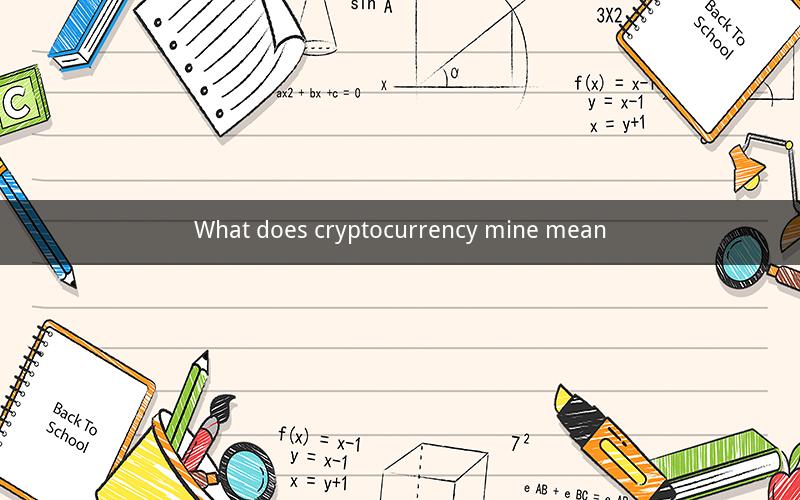
Table of Contents
1. Introduction to Cryptocurrency Mining
2. Understanding the Concept of Mining
3. The Importance of Mining in Cryptocurrency
4. The Process of Mining
5. The Hardware and Software Used in Mining
6. The Challenges of Mining
7. The Environmental Impact of Mining
8. The Future of Cryptocurrency Mining
9. The Role of Mining Pools
10. Conclusion
---
1. Introduction to Cryptocurrency Mining
Cryptocurrency mining is a process that secures a cryptocurrency network and validates transactions. Miners use their computing power to solve complex mathematical problems, which in turn help to maintain the integrity and security of the network. In return, miners are rewarded with cryptocurrency, usually in the form of newly minted coins.
2. Understanding the Concept of Mining
Mining is akin to a digital gold rush. It involves using computer hardware to solve complex mathematical puzzles that help to confirm transactions and add new blocks to the blockchain. The first person to solve the puzzle receives the reward, which is a new coin.
3. The Importance of Mining in Cryptocurrency
Mining plays a crucial role in the functioning of a cryptocurrency network. It ensures the network's security, as miners must prove their ownership of a significant amount of computing power to participate. Additionally, mining helps to maintain the decentralized nature of cryptocurrencies, as it prevents any single entity from controlling the network.
4. The Process of Mining
The process of mining involves the following steps:
- Initialization: Miners set up their mining rig, which includes a computer, GPU, and cooling system.
- Download the Blockchain: Miners download the blockchain, which is a record of all transactions.
- Join a Mining Pool: Many miners join mining pools to increase their chances of solving a puzzle and receiving a reward.
- Run the Mining Software: Miners run mining software on their rigs, which helps to solve mathematical puzzles.
- Validation: Once a miner solves a puzzle, the network validates the solution.
- Reward: The miner receives a reward for solving the puzzle.
5. The Hardware and Software Used in Mining
Mining requires specialized hardware and software. The hardware includes:
- ASIC Miners: These are specialized computers designed for mining.
- GPU Miners: Graphics cards are commonly used for mining.
- CPU Miners: CPUs are less efficient for mining but can still be used.
The software used for mining includes:
- Mining Pools Software: This software connects miners to a mining pool.
- Mining Software: This software runs on the miner's rig and helps to solve mathematical puzzles.
6. The Challenges of Mining
Mining faces several challenges, including:
- High Energy Consumption: Mining requires a significant amount of energy, which has raised concerns about its environmental impact.
- High Costs: The cost of hardware and electricity can be prohibitive for many miners.
- Market Volatility: The value of cryptocurrencies can fluctuate wildly, which can affect the profitability of mining.
7. The Environmental Impact of Mining
Mining has a significant environmental impact due to its high energy consumption. The process emits large amounts of greenhouse gases, which contribute to climate change. Additionally, mining can lead to water pollution and habitat destruction.
8. The Future of Cryptocurrency Mining
The future of cryptocurrency mining is uncertain. As the difficulty of mining increases, the profitability of mining may decrease. However, advancements in technology and the development of more efficient mining equipment may help to mitigate these challenges.
9. The Role of Mining Pools
Mining pools are groups of miners who work together to solve puzzles. By joining a mining pool, miners increase their chances of receiving a reward. Mining pools also help to distribute the rewards more evenly among participants.
10. Conclusion
Cryptocurrency mining is a complex and resource-intensive process. While it plays a crucial role in maintaining the security and decentralized nature of cryptocurrencies, it also faces several challenges. As the technology continues to evolve, the future of mining remains uncertain.
---
Questions and Answers
1. What is cryptocurrency mining?
- Cryptocurrency mining is the process of using computer hardware to solve complex mathematical problems to secure a cryptocurrency network and validate transactions.
2. Why is mining important in cryptocurrency?
- Mining is crucial for maintaining the security and decentralized nature of cryptocurrencies.
3. What hardware is used for mining?
- Mining hardware includes ASIC miners, GPU miners, and CPU miners.
4. What software is used for mining?
- Mining software includes mining pool software and mining software.
5. What are the challenges of mining?
- The challenges of mining include high energy consumption, high costs, and market volatility.
6. What is the environmental impact of mining?
- Mining has a significant environmental impact due to its high energy consumption and emissions.
7. How do mining pools work?
- Mining pools are groups of miners who work together to solve puzzles, increasing their chances of receiving a reward.
8. What is the future of cryptocurrency mining?
- The future of mining is uncertain, but advancements in technology and the development of more efficient mining equipment may help to mitigate challenges.
9. How does mining affect the value of cryptocurrencies?
- Mining can affect the value of cryptocurrencies by influencing supply and demand.
10. What are some alternative methods of securing a cryptocurrency network?
- Alternative methods of securing a cryptocurrency network include proof of stake (PoS) and proof of authority (PoA).